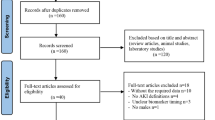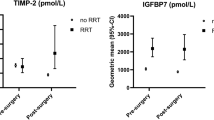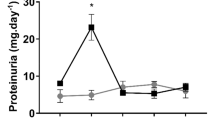Abstract
Backgroud
Urinary tissue inhibitor of metalloproteinase-2 (TIMP-2), insulin-like growth factor binding protein-7 (IGFBP-7) and the combination of TIMP-2 and IGFBP-7 ([TIMP-2]•[IGFBP7]) are proposed to be predictive biomarkers for acute kidney injury (AKI). The intention of our study was to determine whether there is any significant predictive value of these biomarkers for the occurrence of AKI and severe AKI in critically ill neonates.
Methods
Urinary samples were serially collected in 237 neonates during neonatal intensive care unit (NICU) stay for measurements of TIMP-2 and IGFBP-7 in this prospective study. AKI diagnosis was based on KDIGO classification without urine output or serum creatinine >1.2 mg/dL.
Results
Twenty neonates developed AKI, including 11 with KDIGO stage 1, defined as mild AKI, and 9 with stages 2 and 3, defined as severe AKI. Urinary IGFBP-7 and [TIMP-2]•[IGFBP7] remained associated with AKI after adjustment for gestational age, gender and illness severity. Urinary [TIMP-2]•[IGFBP7] achieved an AUC of 0.71 (P = 0.034) and displayed a sensitivity of 88.9% and a specificity of 50.9% for discriminating severe AKI at the optimal cut-off value of 0.045.
Conclusion
The combination of TIMP-2 and IGFBP-7 had independent discriminative value for severe AKI in critically ill neonates.
Similar content being viewed by others
Log in or create a free account to read this content
Gain free access to this article, as well as selected content from this journal and more on nature.com
or
References
Kaddourah, A., Basu, R. K., Bagshaw, S. M., Goldstein, S. L. & Investigators, A. Epidemiology of acute kidney injury in critically ill children and young adults. N. Engl. J. Med. 376, 11–20 (2017).
Peters, E. et al. A worldwide multicentre evaluation of the influence of deterioration or improvement of acute kidney injury on clinical outcome in critically ill patients with and without sepsis at ICU admission: results from The Intensive Care Over Nations audit. Crit. Care 22, 188 (2018).
Selewski, D. T. et al. Neonatal acute kidney injury. Pediatrics 136, e463–e473 (2015).
Waldherr, S. et al. Urinary acute kidney injury biomarkers in very low-birth-weight infants on indomethacin for patent ductus arteriosus. Pediatr. Res. 85, 678–686 (2019).
Hanna, M. et al. Early urinary biomarkers of acute kidney injury in preterm infants. Pediatr. Res. 80, 218–223 (2016).
Ostermann, M. et al. Kinetics of urinary cell cycle arrest markers for acute kidney injury following exposure to potential renal insults. Crit. Care Med. 46, 375–383 (2018).
Kashani, K. et al. Discovery and validation of cell cycle arrest biomarkers in human acute kidney injury. Crit. Care 17, R25 (2013).
Hoste, E. A. et al. Derivation and validation of cutoffs for clinical use of cell cycle arrest biomarkers. Nephrol. Dial. Transplant. 29, 2054–2061 (2014).
Wetz, A. J. et al. Quantification of urinary TIMP-2 and IGFBP-7: an adequate diagnostic test to predict acute kidney injury after cardiac surgery? Crit. Care 19, 3 (2015).
Vijayan, A. et al. Clinical use of the urine biomarker [TIMP-2] x [IGFBP7] for Acute Kidney Injury Risk Assessment. Am. J. Kidney Dis. 68, 19–28 (2016).
Yamashita, T. et al. Evaluation of urinary tissue inhibitor of metalloproteinase-2 in acute kidney injury: a prospective observational study. Crit. Care 18, 716 (2014).
Bai, Z. et al. Serum and urine FGF23 and IGFBP-7 for the prediction of acute kidney injury in critically ill children. BMC Pediatr. 18, 192 (2018).
Bihorac, A. et al. Validation of cell-cycle arrest biomarkers for acute kidney injury using clinical adjudication. Am. J. Respir. Crit. Care Med. 189, 932–939 (2014).
Lameire, N., Vanmassenhove, J., Van Biesen, W. & Vanholder, R. The cell cycle biomarkers: promising research, but do not oversell them. Clin. Kidney J. 9, 353–358 (2016).
Bell, M., Larsson, A., Venge, P., Bellomo, R. & Martensson, J. Assessment of cell-cycle arrest biomarkers to predict early and delayed acute kidney injury. Dis. Markers 2015, 158658 (2015).
Perico, N., Askenazi, D., Cortinovis, M. & Remuzzi, G. Maternal and environmental risk factors for neonatal AKI and its long-term consequences. Nat. Rev. Nephrol. 14, 688–703 (2018).
Sutherland, S. M. et al. AKI in hospitalized children: epidemiology and clinical associations in a national cohort. Clin. J. Am. Soc. Nephrol. 8, 1661–1669 (2013).
Richardson, D. K., Gray, J. E., McCormick, M. C., Workman, K. & Goldmann, D. A. Score for Neonatal Acute Physiology: a physiologic severity index for neonatal intensive care. Pediatrics 91, 617–623 (1993).
Li, Y. et al. Addition of SNAP to perinatal risk factors improves the prediction of bronchopulmonary dysplasia or death in critically ill preterm infants. BMC Pediatr. 13, 138 (2013).
Hoffman, S. B., Massaro, A. N., Soler-Garcia, A. A., Perazzo, S. & Ray, P. E. A novel urinary biomarker profile to identify acute kidney injury (AKI) in critically ill neonates: a pilot study. Pediatr. Nephrol. 28, 2179–2188 (2013).
Jetton, J. G. et al. Incidence and outcomes of neonatal acute kidney injury (AWAKEN): a multicentre, multinational, observational cohort study. Lancet Child Adolesc. Health 1, 184–194 (2017).
Li, Y. et al. Urine interleukin-18 and cystatin-C as biomarkers of acute kidney injury in critically ill neonates. Pediatr. Nephrol. 27, 851–860 (2012).
Prowle, J. R. Acute kidney injury: creatinine and AKI–through a glass, darkly. Nat. Rev. Nephrol. 9, 193–195 (2013).
Askenazi, D. J., Ambalavanan, N. & Goldstein, S. L. Acute kidney injury in critically ill newborns: what do we know? What do we need to learn? Pediatr. Nephrol. 24, 265–274 (2009).
Haase, M., Kellum, J. A. & Ronco, C. Subclinical AKI–an emerging syndrome with important consequences. Nat. Rev. Nephrol. 8, 735–739 (2012).
Stachenfeld, N. S., Splenser, A. E., Calzone, W. L., Taylor, M. P. & Keefe, D. L. Sex differences in osmotic regulation of AVP and renal sodium handling. J. Appl Physiol. (1985) 91, 1893–1901 (2001).
Zelenina, M. et al. Urinary aquaporin-2 excretion during early human development. Pediatr. Nephrol. 21, 947–952 (2006).
Bagshaw, S. M., George, C., Bellomo, R. & Committee, A. D. M. Early acute kidney injury and sepsis: a multicentre evaluation. Crit. Care 12, R47 (2008).
Neugarten, J. & Golestaneh, L. Female sex reduces the risk of hospital-associated acute kidney injury: a meta-analysis. BMC Nephrol. 19, 314 (2018).
Satake, A. et al. Protective effect of 17beta-estradiol on ischemic acute renal failure through the PI3K/Akt/eNOS pathway. Kidney Int. 73, 308–317 (2008).
Tanaka, R. et al. Sex differences in ischaemia/reperfusion-induced acute kidney injury depends on the degradation of noradrenaline by monoamine oxidase. Clin. Exp. Pharm. Physiol. 44, 371–377 (2017).
Muller, V. et al. Sexual dimorphism in renal ischemia-reperfusion injury in rats: possible role of endothelin. Kidney Int. 62, 1364–1371 (2002).
Gist, K. M. et al. Kinetics of the cell cycle arrest biomarkers (TIMP-2*IGFBP-7) for prediction of acute kidney injury in infants after cardiac surgery. Pediatr. Nephrol. 32, 1611–1619 (2017).
Gist, K. M. et al. Acute kidney injury biomarkers predict an increase in serum milrinone concentration earlier than serum creatinine-defined acute kidney injury in infants after cardiac surgery. Ther. Drug Monit. 40, 186–194 (2018).
Emlet, D. R. et al. Insulin-like growth factor binding protein 7 and tissue inhibitor of metalloproteinases-2: differential expression and secretion in human kidney tubule cells. Am. J. Physiol. Ren. Physiol. 312, F284–F296 (2017).
Emlet, D. R., Wen, X. & Kellum, J. A. Comments on the Review ‘Biomarkers in acute kidney injury - pathophysiological basis and clinical performance' Acta Physiol. 2017, 219, 556-574: an update on kidney localization of IGFBP7 and TIMP2. Acta Physiol. (Oxf.) 222, e12934 (2018).
Schrezenmeier, E. V., Barasch, J., Budde, K., Westhoff, T. & Schmidt-Ott, K. M. Biomarkers in acute kidney injury - pathophysiological basis and clinical performance. Acta Physiol. (Oxf.) 219, 554–572 (2017).
Bezerra, C. T., Vaz Cunha, L. C. & Liborio, A. B. Defining reduced urine output in neonatal ICU: importance for mortality and acute kidney injury classification. Nephrol. Dial. Transplant. 28, 901–909 (2013).
Liborio, A. B., Branco, K. M. & Torres de Melo Bezerra, C. Acute kidney injury in neonates: from urine output to new biomarkers. BioMed. Res. Int. 2014, 601568 (2014).
Acknowledgements
We thank the staff in biochemistry laboratory for technical assistance. This work was supported by grants from the National Natural Science Foundation of China (81370773, 81741054, 81971432), JiangSu province science and technology support Program (Social Development BE2016675), Natural Science Foundation of Jiangsu province (BK20171217), Key talent of women’s and children’s health of JiangSu province (FRC201738), SuZhou clinical key disease diagnosis and treatment technology foundation (LCZX201611), SuZhou science and technology development project (SYS201760). The funders had no role in the study design, data collection, preparation of the manuscript, and decision to publish.
Author information
Authors and Affiliations
Contributions
J.C. participated in data analysis and drafted the manuscript. Y.S. performed the experiments. S.W., X.D. and H.H. participated in collecting the data and samples. X.D. participated in data analysis. Z.B. and X.L. participated in data analysis and interpretation. J.W. participated in the design of the study and coordination. Y.L. had primary responsibility for study design, performing the experiments, data analysis, interpretation of data, and writing of the manuscript. All authors read and approved the final manuscript.
Corresponding author
Ethics declarations
Competing interests
The authors declare no competing interests.
Additional information
Publisher’s note Springer Nature remains neutral with regard to jurisdictional claims in published maps and institutional affiliations.
Rights and permissions
About this article
Cite this article
Chen, J., Sun, Y., Wang, S. et al. The effectiveness of urinary TIMP-2 and IGFBP-7 in predicting acute kidney injury in critically ill neonates. Pediatr Res 87, 1052–1059 (2020). https://doi.org/10.1038/s41390-019-0698-8
Received:
Revised:
Accepted:
Published:
Issue date:
DOI: https://doi.org/10.1038/s41390-019-0698-8
This article is cited by
-
Evaluation of uNGAL and TIMP-2*IGFBP7 as early biomarkers of Acute Kidney Injury in Caucasian term and preterm neonates: a prospective observational cohort study
Italian Journal of Pediatrics (2025)
-
Advances in pediatric acute kidney injury detection and prediction: biomarkers and artificial intelligence
World Journal of Pediatrics (2025)
-
The promise of biomarkers: precision medicine will pave a roadmap for pediatric acute kidney injury management in critically ill children
Intensive Care Medicine – Paediatric and Neonatal (2025)
-
Insulin-like growth factor-1 effects on kidney development in preterm piglets
Pediatric Research (2024)
-
Artificial intelligence in early detection and prediction of pediatric/neonatal acute kidney injury: current status and future directions
Pediatric Nephrology (2024)



